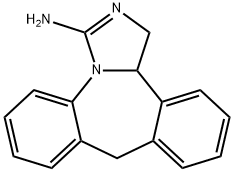Epinastine , ≥98% , 80012-43-7
CAS NO.:80012-43-7
Empirical Formula: C16H15N3
Molecular Weight: 249.31
MDL number: MFCD00865648
EINECS: 616-785-3
| Pack Size | Price | Stock | Quantity |
| 50mg | RMB551.20 | In Stock |
|
| 100mg | RMB986.40 | In Stock |
|
| others | Enquire |
PRODUCT Properties
| Melting point: | 205-208° |
| Boiling point: | 428.0±55.0 °C(Predicted) |
| Density | 1.32±0.1 g/cm3(Predicted) |
| storage temp. | Keep in dark place,Inert atmosphere,Room temperature |
| solubility | DMSO : ≥ 50 mg/mL (200.55 mM);Water : < 0.1 mg/mL (insoluble) |
| pka | 11.2(at 25℃) |
| form | Solid |
| color | White to off-white |
| CAS DataBase Reference | 80012-43-7(CAS DataBase Reference) |
Description and Uses
Epinastine hydrochloride, an orally active antihistaminic agent, was marketed in Japan for the treatment of bronchial asthma, allergic rhinitis, urticaria, eczema, dermatitis, and psoriasis vulgaris.Epinastine is one of the most effective peripherally acting histamine H1-receptor antagonists without sedative effects.In addition, it exhibits potent anti-PAF and anti-LT activity which may also contribute significantly to its antiallergic activity. Chronic epinastine has been reported to effectively inhibit airway hyper-responsiveness in rats. Potent inhibitory effects of epinastine on bronchoconstriction induced by histamine and bradykinin, but not by other chemical mediators, has also been reported. Studies have indicated that there are no significant differences in pharmacological properties among D-, L-, and racemic epinastine.
Epinastine is antihistamine and mast cell stabilize that is used in eye drops for the treatment of allergic conjunctivitis.
Safety
| Symbol(GHS) |    GHS07,GHS08,GHS09 |
| Signal word | Danger |
| Hazard statements | H302-H411-H372 |
| Precautionary statements | P273-P280 |



